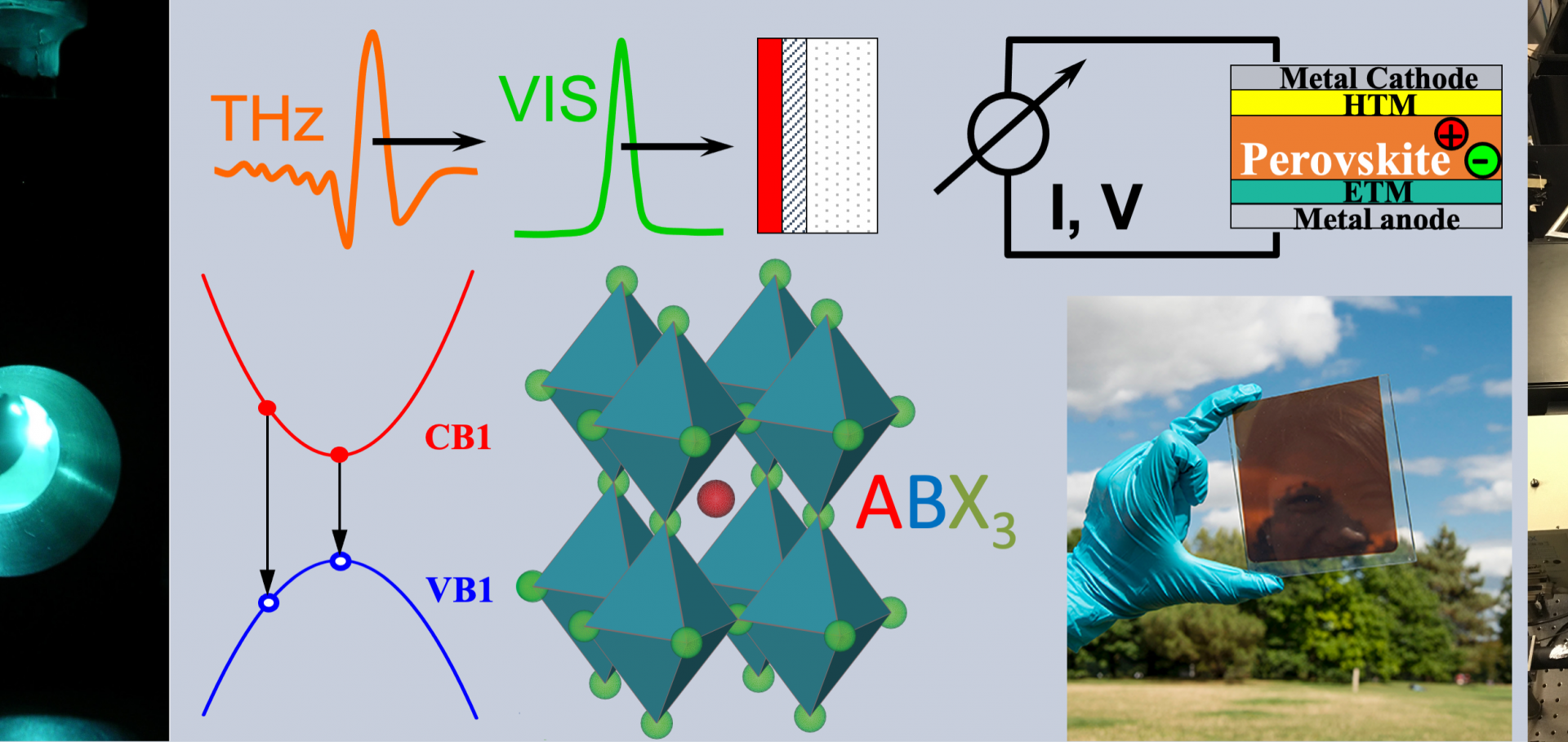Charge-carrier dynamics, mobilities and diffusion lengths of 2D-3D hybrid butylammonium-caesium-formamidinium lead halide perovskites
Abstract:
Perovskite solar cells (PSCs) have improved dramatically over the past decade, increasing in efficiency and gradually overcoming hurdles of temperature‐ and humidity‐induced instability. Materials that combine high charge‐carrier lifetimes and mobilities, strong absorption, and good crystallinity of 3D perovskites with the hydrophobic properties of 2D perovskites have become particularly promising candidates for use in solar cells. In order to fully understand the optoelectronic properties of these 2D–3D hybrid systems, the hybrid perovskite BAx(FA0.83Cs0.17)1‐xPb(I0.6Br0.4)3 is investigated across the composition range 0 ≤ x ≤ 0.8. Small amounts of butylammonium (BA) are found that help to improve crystallinity and appear to passivate grain boundaries, thus reducing trap‐mediated charge‐carrier recombination and enhancing charge‐carrier mobilities. Excessive amounts of BA lead to poor crystallinity and inhomogeneous film formation, greatly reducing effective charge‐carrier mobility. For low amounts of BA, the benevolent effects of reduced recombination and enhanced mobilities lead to charge‐carrier diffusion lengths up to 7.7 µm for x = 0.167. These measurements pave the way for highly efficient, highly stable PSCs and other optoelectronic devices based on 2D–3D hybrid materials.Effect of ultraviolet radiation on organic photovoltaic materials and devices
Abstract:
Organic photovoltaics are a sustainable and cost-effective power-generation technology that may aid the move to zero-emission buildings, carbon neutral cities, and electric vehicles. While state-of-the-art organic photovoltaic devices can be encapsulated to withstand air and moisture, they are currently still susceptible to light-induced degradation, leading to a decline in the long-term efficiency of the devices. In this study, the role of ultraviolet (UV) radiation on a multilayer organic photovoltaic device is systematically uncovered using spectral filtering. By applying long-pass filters to remove different parts of the UV portion of the AM1.5G spectrum, two main photodegradation processes are shown to occur in the organic photovoltaic devices. A UV-activated process is found to cause a significant decrease in the photocurrent across the whole spectrum and is most likely linked to the deterioration of the charge extraction layers. In addition, a photodegradation process caused by UV-filtered sunlight is found to change the micromorphology of the bulk heterojunction material, leading to a reduction in photocurrent at high photon energies. These findings strongly suggest that the fabrication of inherently photostable organic photovoltaic devices will require the replacement of fullerene-based electron transporter materials with alternative organic semiconductors.Heterogeneous photon recycling and charge diffusion enhance charge transport in quasi-2D lead-halide perovskite films
Abstract:
The addition of large hydrophobic cations to lead halide perovskites has significantly enhanced the environmental stability of photovoltaic cells based on these materials. However, the associated formation of two-dimensional structures inside the material can lead to dielectric confinement, higher exciton binding energies, wider bandgaps and limited charge-carrier mobilities. Here we show that such effects are not detrimental to the charge transport for carefully processed films comprising a self-assembled thin layer of quasi-two-dimensional (2D) perovskite interfaced with a 3D MAPbI3 perovskite layer. We apply a combination of time-resolved photoluminescence and photoconductivity spectroscopy to reveal the charge-carrier recombination and transport through the film profile, when either the quasi-2D or the 3D layers are selectively excited. Through modeling of the recorded dynamics, we demonstrate that while the charge-carrier mobility is lower within the quasi-2D region, charge-carrier diffusion to the 3D phase leads to a rapid recovery in photoconductivity even when the quasi-2D region is initially photoexcited. In addition, the blue-shifted emission originating from quasi-2D regions overlaps significantly with the absorption spectrum of the 3D perovskite, allowing for highly effective “heterogeneous photon recycling”. We show that this combination fully compensates for the adverse effects of electronic confinement, yielding quasi-2D perovskites with highly efficient charge transporting properties.
Tuning the circumference of six-porphyrin nanorings
Abstract:
Most macrocycles are made from a simple repeat unit, resulting in high symmetry. Breaking this symmetry allows fine-tuning of the circumference, providing better control of the host–guest behavior and electronic structure. Here, we present the template-directed synthesis of two unsymmetrical cyclic porphyrin hexamers with both ethyne (C2) and butadiyne (C4) links, and we compare these nanorings with the symmetrical analogues with six ethyne or six butadiyne links. Inserting two extra carbon atoms into the smaller nanoring causes a spectacular change in binding behavior: the template affinity increases by a factor of 3 × 109, to a value of ca. 1038 M–1, and the mean effective molarity is ca. 830 M. In contrast, removing two carbon atoms from the largest nanoring results in almost no change in its template-affinity. The strain in these nanorings is 90–130 kJ mol–1, as estimated both from DFT calculation of homodesmotic reactions and from comparing template affinities of linear and cyclic oligomers. Breaking the symmetry has little effect on the absorption and fluorescence behavior of the nanorings: the low radiative rates that are characteristic of a circular delocalized S1 excited state are preserved in the low-symmetry macrocycles.


